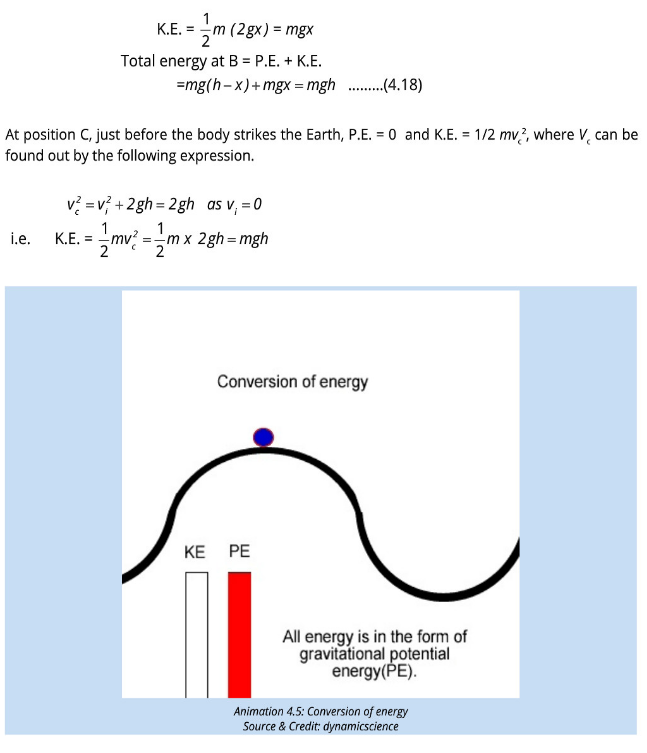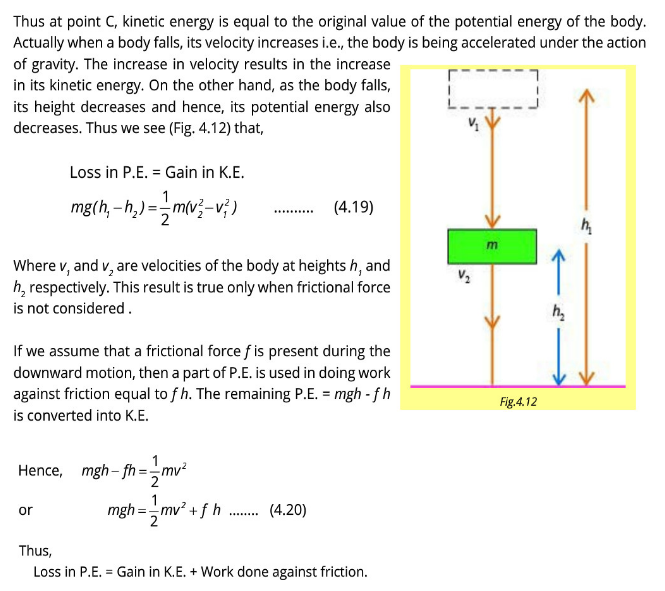Your cart is currently empty!
4.6 Interconversion of Potenial Energy and Kinetic Energy




The interconversion of potential energy and kinetic energy is a fundamental concept in physics, illustrating how energy can change forms while the total energy in an isolated system remains constant. This principle is a key aspect of the law of conservation of energy. Let’s explore this concept in detail:
Potential Energy (PE)
Potential energy is the stored energy of an object due to its position or state. The most common form is gravitational potential energy, which depends on an object’s height and mass.
Gravitational PE=mgh\text{Gravitational PE} = mghGravitational PE=mgh
where:
- mmm is the mass of the object,
- ggg is the acceleration due to gravity (9.8 m/s² on Earth),
- hhh is the height above a reference level.
Kinetic Energy (KE)
Kinetic energy is the energy of an object due to its motion.
KE=12mv2\text{KE} = \frac{1}{2}mv^2KE=21mv2
where:
- mmm is the mass of the object,
- vvv is the velocity of the object.
Interconversion of PE and KE
In many physical situations, potential energy is converted into kinetic energy and vice versa. The total mechanical energy (the sum of potential and kinetic energy) in an isolated system remains constant if only conservative forces (like gravity) are acting.
Example: A Falling Object
- At the highest point: The object has maximum potential energy and zero kinetic energy. Etotal=PEmax+KEmin=mgh+0E_{\text{total}} = PE_{\text{max}} + KE_{\text{min}} = mgh + 0Etotal=PEmax+KEmin=mgh+0
- As the object falls: Potential energy decreases, and kinetic energy increases. The loss in potential energy is equal to the gain in kinetic energy. ΔPE=−ΔKE\Delta PE = -\Delta KEΔPE=−ΔKE mghinitial−mghfinal=12mvfinal2−12mvinitial2mgh_{\text{initial}} – mgh_{\text{final}} = \frac{1}{2}mv_{\text{final}}^2 – \frac{1}{2}mv_{\text{initial}}^2mghinitial−mghfinal=21mvfinal2−21mvinitial2
- Just before hitting the ground: The object has maximum kinetic energy and minimum potential energy. Etotal=PEmin+KEmax=0+12mv2E_{\text{total}} = PE_{\text{min}} + KE_{\text{max}} = 0 + \frac{1}{2}mv^2Etotal=PEmin+KEmax=0+21mv2
Practical Applications
- Pendulum: At the highest points of its swing, a pendulum has maximum potential energy and minimum kinetic energy. At the lowest point, it has maximum kinetic energy and minimum potential energy.
- Roller Coasters: At the top of a hill, the roller coaster has maximum potential energy. As it descends, this potential energy is converted into kinetic energy, causing the roller coaster to accelerate.
Energy Conservation
The principle of conservation of energy states that in an isolated system, the total energy remains constant. Thus, as potential energy converts to kinetic energy or vice versa, the total mechanical energy (if no non-conservative forces like friction are doing work) remains unchanged:
Etotal=PE+KEE_{\text{total}} = PE + KEEtotal=PE+KE
This principle allows us to predict the behavior of objects and understand the natural processes involving energy transformations.

Leave a Reply